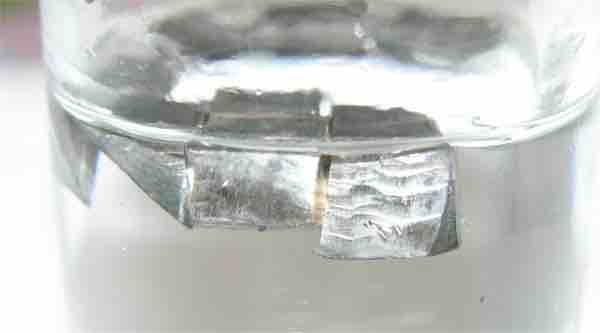The alkali metals are a group of chemical elements in the periodic table with the following physical and chemical properties:
- shiny
- soft
- silvery
- highly reactive at standard temperature and pressure
- readily lose their outermost electron to form cations with a charge of +1
They can all be cut easily with a plastic knife due to their softness, and their shiny surface tarnishes rapidly in air due to oxidation. Because of their high reactivity, alkali metals must be stored under oil to prevent reaction with air. In the modern IUPAC nomenclature, the alkali metals comprise the group 1 elements, excluding hydrogen. All the alkali metals react with water, with the heavier alkali metals reacting more vigorously than the lighter ones.

Alkali Metals
Lithium is stored in oil because of its high reactivity.
Periodic Trends of Alkali Metals
The alkali metals are lithium (Li), sodium (Na), potassium (K), rubidium (Rb), caesium (Cs),and francium (Fr). This group lies in the s-block of the periodic table, as all alkali metals have their outermost electron in an s-orbital. The alkali metals provide the best example of group trends in properties in the periodic table, with elements exhibiting similar properties. For instance, when moving down the table, all known alkali metals show:
- increasing atomic radius,
- decreasing electronegativity
- increasing reactivity
- decreasing melting and boiling points
In general, their densities increase when moving down the table, with the exception of potassium, which is less dense than sodium.
Reactions of Alkali Metals
Alkali metals react violently with water, halogens, and acids. The reactions release surprising amounts of heat and light. In a chemical equation, alkali metals are represented with an M. Here are some sample reaction equations:
- Alkali metals react with oxygen to form oxides, which have a duller appearance and lower reactivity. The oxides are much less reactive than the pure metals.
- The oxides react vigorously with water to form a hydroxide. The resulting hydroxides of these elements dissociate completely in water to form some of the strongest bases known. Sodium hydroxide (NaOH), also called lye, is an industrial-strength base.
- The pure alkali metal can also react directly with water. In this case, the metal is a basic anhydride. Gaseous hydrogen is released, which is flammable.
- Exposing an alkali metal to a halogen will cause an extremely exothermic reaction that results in an ionic salt. Almost every salt of an alkali metal is highly soluble in water. They form conducting solutions, proving their ionic nature.
Occurrence in Nature
All the discovered alkali metals occur in nature. Experiments have been conducted to attempt the synthesis of ununennium (Uue), which is likely to be the next member of the group if the attempt is successful. It is predicted that the next alkali metal after ununennium would be unhexpentium (Uhp), an element that has not yet received even attempts at synthesis due to its extremely high atomic number.
Applications of Alkali Metals
Most alkali metals have many different applications. Two of the most well-known applications of the pure elements are rubidium and cesium atomic clocks, of which cesium atomic clocks are the most accurate representation of time known as of 2012. A common application of the compounds of sodium is the sodium-vapor lamp, which emits very efficient light. Table salt, or sodium chloride, on the other hand, has been used since antiquity.